A Research Project: COVID-19's Impact on Customer Buying Behavior
VerifiedAdded on 2023/06/14
|15
|4050
|257
Project
AI Summary
This research project investigates the influence of the COVID-19 pandemic on customer buying behavior, particularly focusing on the shift between online and offline shopping preferences in the UK. The study employs both primary and secondary data collection methods, including a questionnaire survey with 20 UK residents and a literature review of existing research on retail transformation, factors impacting buying behavior, and motivations/deterrents for online and offline shopping. The findings reveal that the pandemic has significantly altered consumer behavior, with increased reliance on online platforms due to safety concerns and convenience. The research identifies key factors influencing purchasing decisions, such as fear of infection, perceived benefits of online shopping (e.g., convenience, product comparison), and traditional motivations for offline shopping (e.g., socialization, immediate gratification). The analysis of survey data highlights the prevalence of concerns regarding COVID-19 infection as a deterrent for offline shopping and underscores the growing preference for online stores for their accessibility and perceived safety during the pandemic.
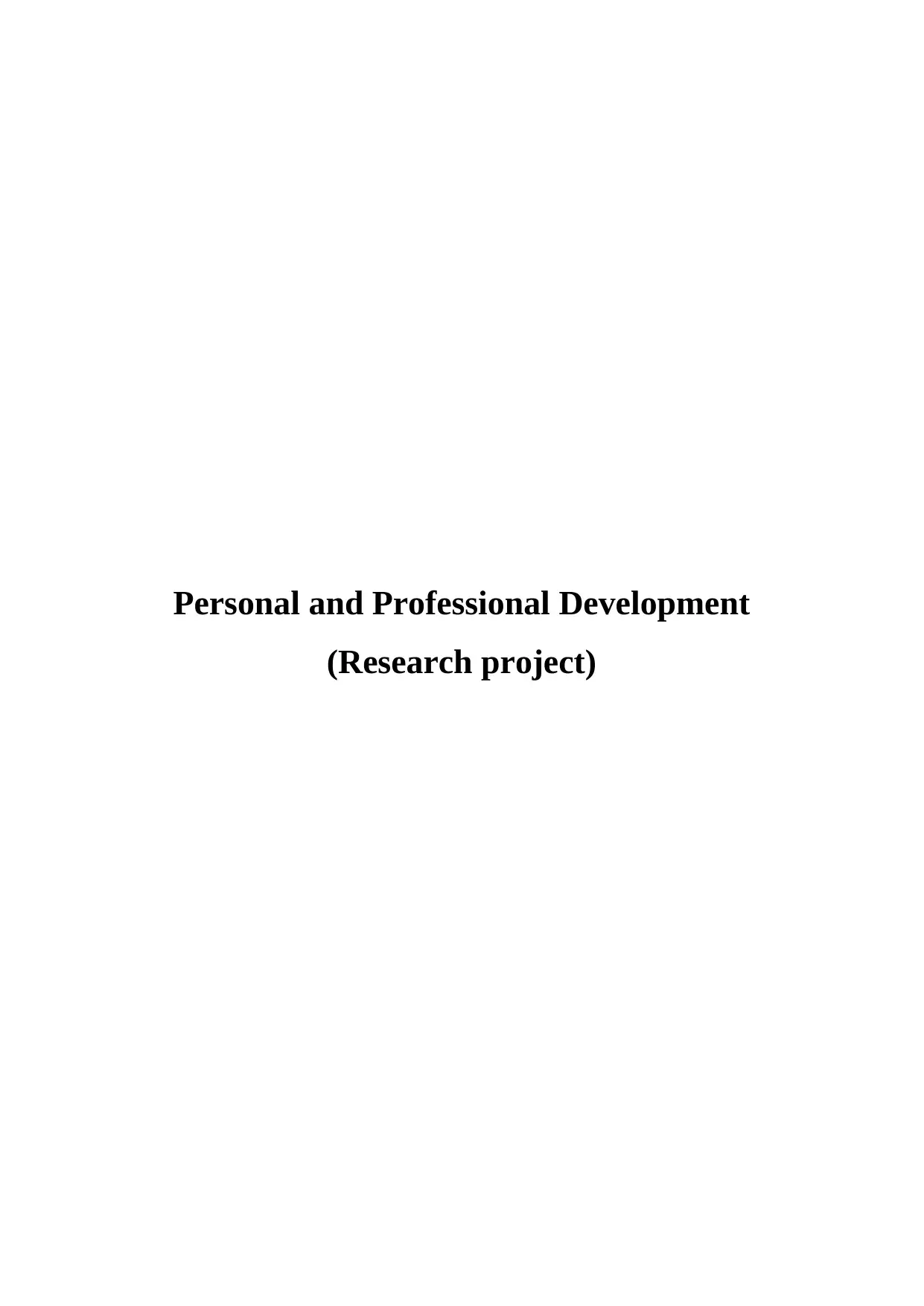
Personal and Professional Development
(Research project)
(Research project)
Paraphrase This Document
Need a fresh take? Get an instant paraphrase of this document with our AI Paraphraser
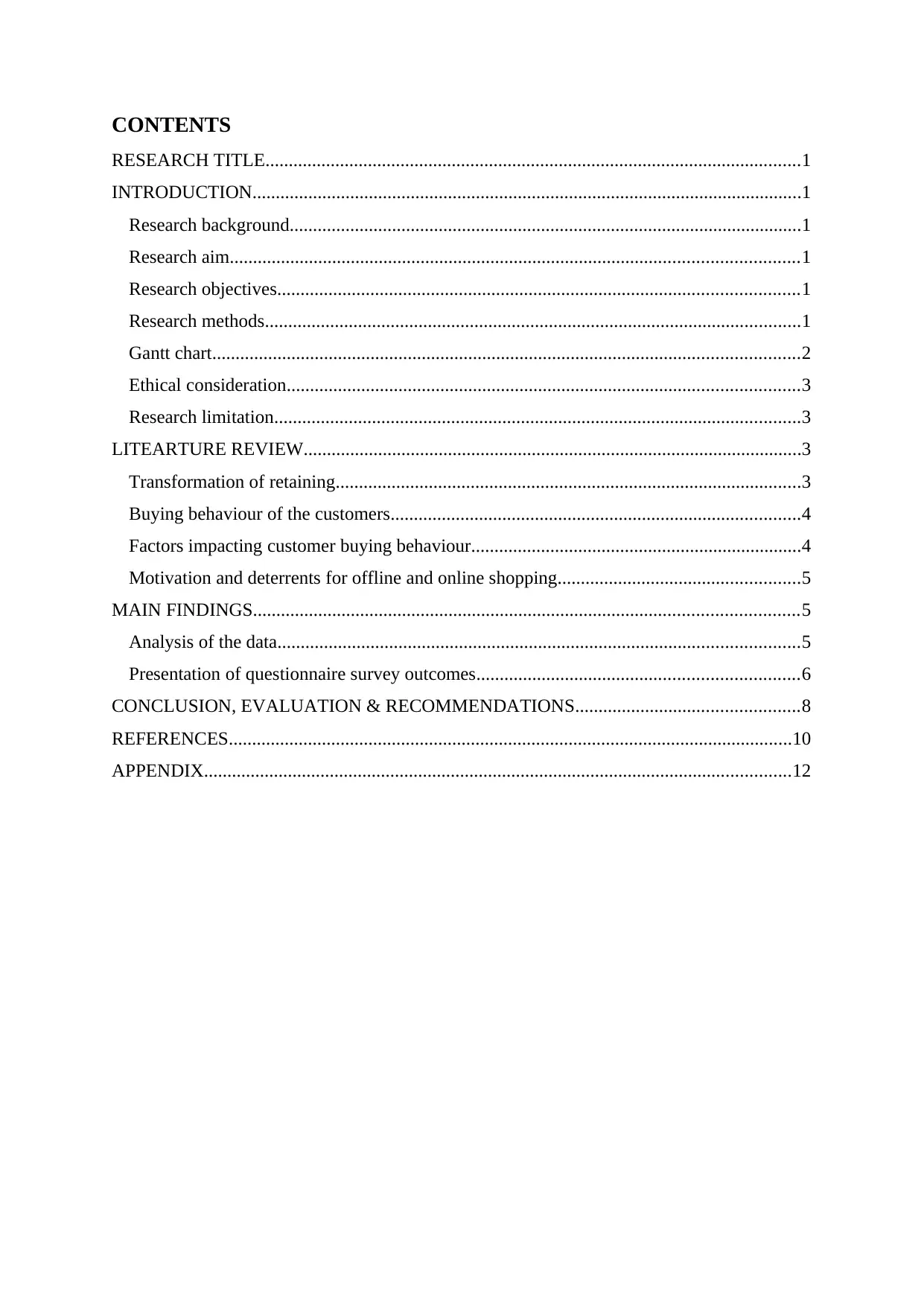
CONTENTS
RESEARCH TITLE...................................................................................................................1
INTRODUCTION......................................................................................................................1
Research background..............................................................................................................1
Research aim..........................................................................................................................1
Research objectives................................................................................................................1
Research methods...................................................................................................................1
Gantt chart..............................................................................................................................2
Ethical consideration..............................................................................................................3
Research limitation.................................................................................................................3
LITEARTURE REVIEW...........................................................................................................3
Transformation of retaining....................................................................................................3
Buying behaviour of the customers........................................................................................4
Factors impacting customer buying behaviour.......................................................................4
Motivation and deterrents for offline and online shopping....................................................5
MAIN FINDINGS.....................................................................................................................5
Analysis of the data................................................................................................................5
Presentation of questionnaire survey outcomes.....................................................................6
CONCLUSION, EVALUATION & RECOMMENDATIONS................................................8
REFERENCES.........................................................................................................................10
APPENDIX..............................................................................................................................12
RESEARCH TITLE...................................................................................................................1
INTRODUCTION......................................................................................................................1
Research background..............................................................................................................1
Research aim..........................................................................................................................1
Research objectives................................................................................................................1
Research methods...................................................................................................................1
Gantt chart..............................................................................................................................2
Ethical consideration..............................................................................................................3
Research limitation.................................................................................................................3
LITEARTURE REVIEW...........................................................................................................3
Transformation of retaining....................................................................................................3
Buying behaviour of the customers........................................................................................4
Factors impacting customer buying behaviour.......................................................................4
Motivation and deterrents for offline and online shopping....................................................5
MAIN FINDINGS.....................................................................................................................5
Analysis of the data................................................................................................................5
Presentation of questionnaire survey outcomes.....................................................................6
CONCLUSION, EVALUATION & RECOMMENDATIONS................................................8
REFERENCES.........................................................................................................................10
APPENDIX..............................................................................................................................12
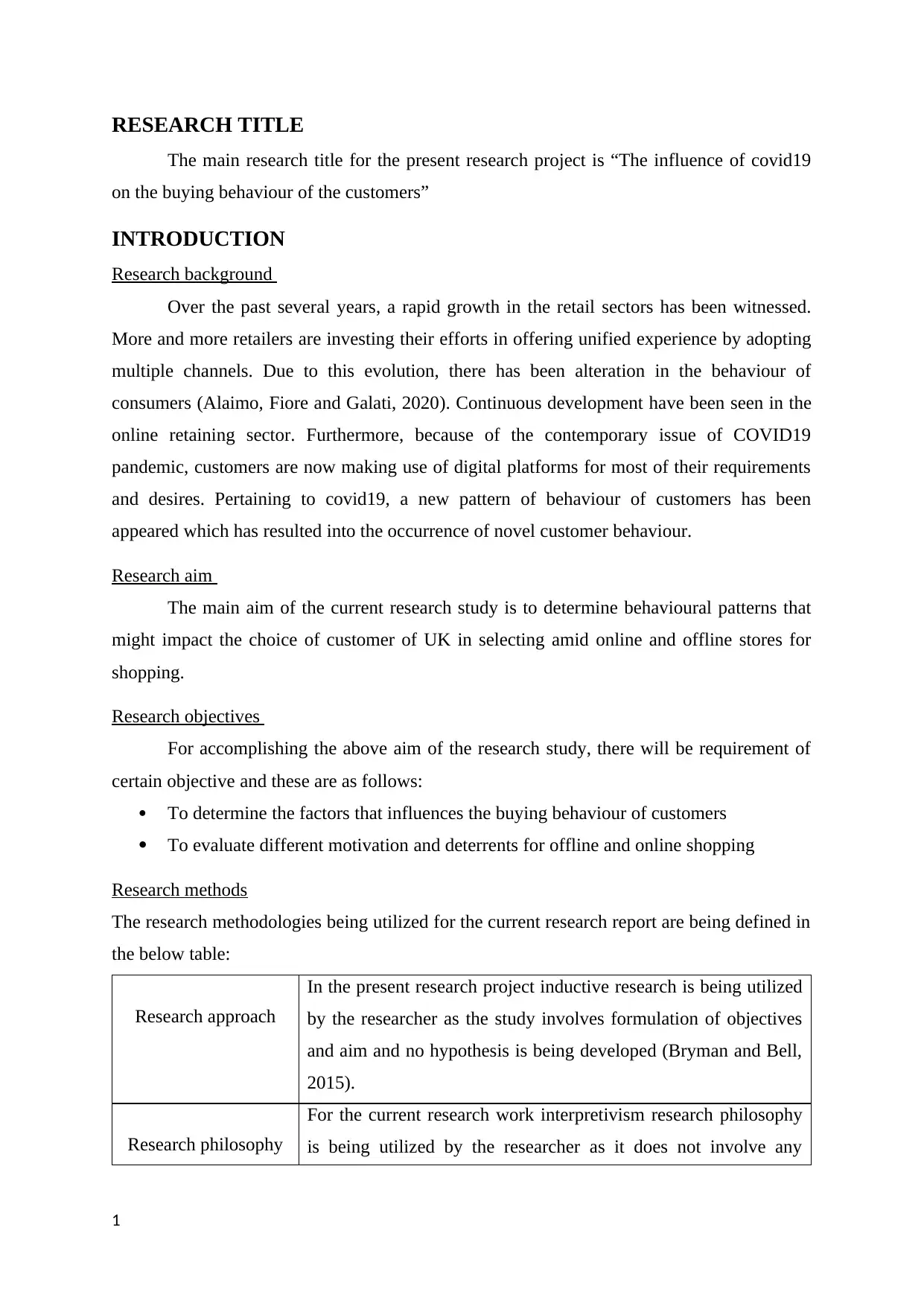
RESEARCH TITLE
The main research title for the present research project is “The influence of covid19
on the buying behaviour of the customers”
INTRODUCTION
Research background
Over the past several years, a rapid growth in the retail sectors has been witnessed.
More and more retailers are investing their efforts in offering unified experience by adopting
multiple channels. Due to this evolution, there has been alteration in the behaviour of
consumers (Alaimo, Fiore and Galati, 2020). Continuous development have been seen in the
online retaining sector. Furthermore, because of the contemporary issue of COVID19
pandemic, customers are now making use of digital platforms for most of their requirements
and desires. Pertaining to covid19, a new pattern of behaviour of customers has been
appeared which has resulted into the occurrence of novel customer behaviour.
Research aim
The main aim of the current research study is to determine behavioural patterns that
might impact the choice of customer of UK in selecting amid online and offline stores for
shopping.
Research objectives
For accomplishing the above aim of the research study, there will be requirement of
certain objective and these are as follows:
To determine the factors that influences the buying behaviour of customers
To evaluate different motivation and deterrents for offline and online shopping
Research methods
The research methodologies being utilized for the current research report are being defined in
the below table:
Research approach
In the present research project inductive research is being utilized
by the researcher as the study involves formulation of objectives
and aim and no hypothesis is being developed (Bryman and Bell,
2015).
Research philosophy
For the current research work interpretivism research philosophy
is being utilized by the researcher as it does not involve any
1
The main research title for the present research project is “The influence of covid19
on the buying behaviour of the customers”
INTRODUCTION
Research background
Over the past several years, a rapid growth in the retail sectors has been witnessed.
More and more retailers are investing their efforts in offering unified experience by adopting
multiple channels. Due to this evolution, there has been alteration in the behaviour of
consumers (Alaimo, Fiore and Galati, 2020). Continuous development have been seen in the
online retaining sector. Furthermore, because of the contemporary issue of COVID19
pandemic, customers are now making use of digital platforms for most of their requirements
and desires. Pertaining to covid19, a new pattern of behaviour of customers has been
appeared which has resulted into the occurrence of novel customer behaviour.
Research aim
The main aim of the current research study is to determine behavioural patterns that
might impact the choice of customer of UK in selecting amid online and offline stores for
shopping.
Research objectives
For accomplishing the above aim of the research study, there will be requirement of
certain objective and these are as follows:
To determine the factors that influences the buying behaviour of customers
To evaluate different motivation and deterrents for offline and online shopping
Research methods
The research methodologies being utilized for the current research report are being defined in
the below table:
Research approach
In the present research project inductive research is being utilized
by the researcher as the study involves formulation of objectives
and aim and no hypothesis is being developed (Bryman and Bell,
2015).
Research philosophy
For the current research work interpretivism research philosophy
is being utilized by the researcher as it does not involve any
1
⊘ This is a preview!⊘
Do you want full access?
Subscribe today to unlock all pages.

Trusted by 1+ million students worldwide
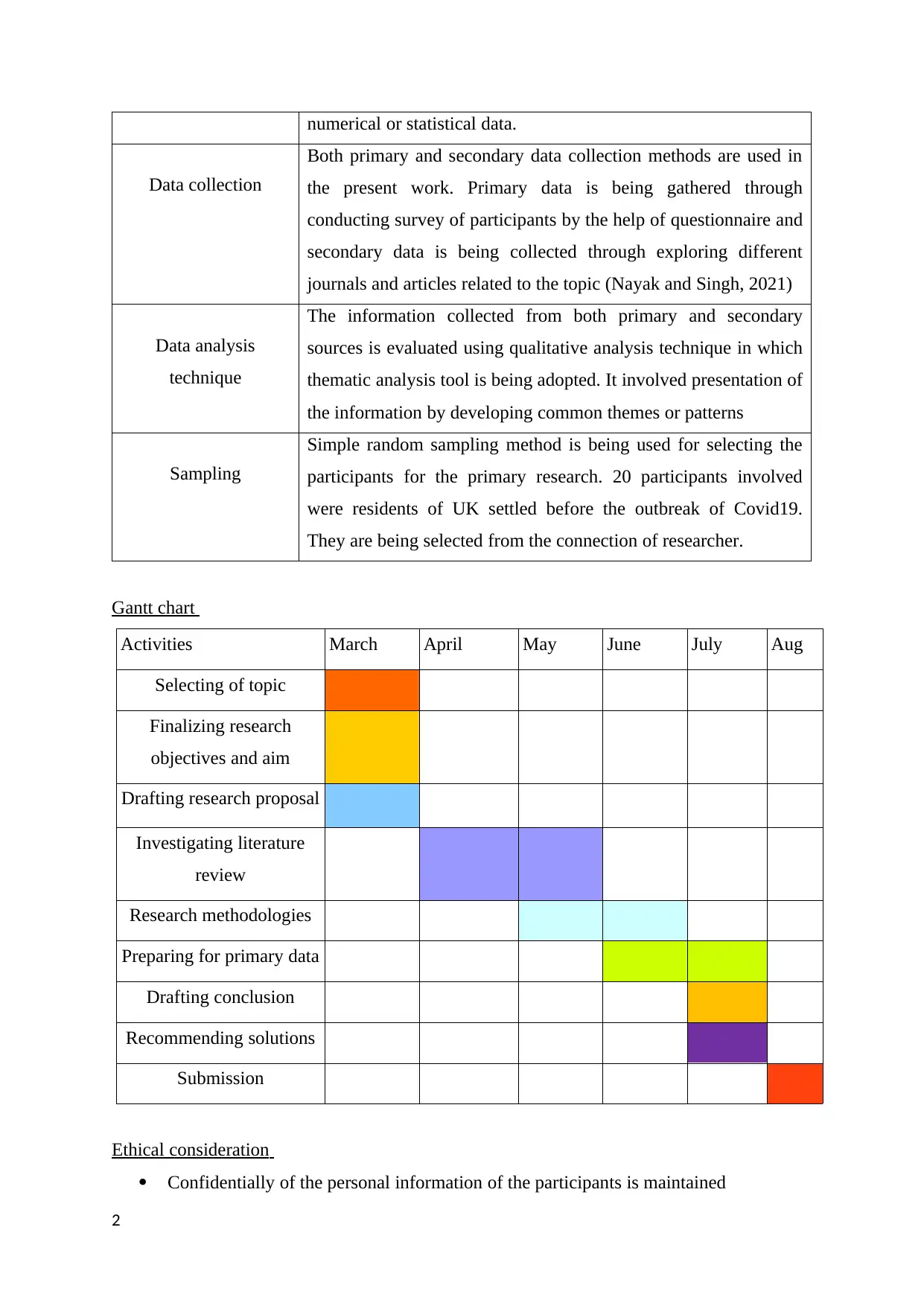
numerical or statistical data.
Data collection
Both primary and secondary data collection methods are used in
the present work. Primary data is being gathered through
conducting survey of participants by the help of questionnaire and
secondary data is being collected through exploring different
journals and articles related to the topic (Nayak and Singh, 2021)
Data analysis
technique
The information collected from both primary and secondary
sources is evaluated using qualitative analysis technique in which
thematic analysis tool is being adopted. It involved presentation of
the information by developing common themes or patterns
Sampling
Simple random sampling method is being used for selecting the
participants for the primary research. 20 participants involved
were residents of UK settled before the outbreak of Covid19.
They are being selected from the connection of researcher.
Gantt chart
Activities March April May June July Aug
Selecting of topic
Finalizing research
objectives and aim
Drafting research proposal
Investigating literature
review
Research methodologies
Preparing for primary data
Drafting conclusion
Recommending solutions
Submission
Ethical consideration
Confidentially of the personal information of the participants is maintained
2
Data collection
Both primary and secondary data collection methods are used in
the present work. Primary data is being gathered through
conducting survey of participants by the help of questionnaire and
secondary data is being collected through exploring different
journals and articles related to the topic (Nayak and Singh, 2021)
Data analysis
technique
The information collected from both primary and secondary
sources is evaluated using qualitative analysis technique in which
thematic analysis tool is being adopted. It involved presentation of
the information by developing common themes or patterns
Sampling
Simple random sampling method is being used for selecting the
participants for the primary research. 20 participants involved
were residents of UK settled before the outbreak of Covid19.
They are being selected from the connection of researcher.
Gantt chart
Activities March April May June July Aug
Selecting of topic
Finalizing research
objectives and aim
Drafting research proposal
Investigating literature
review
Research methodologies
Preparing for primary data
Drafting conclusion
Recommending solutions
Submission
Ethical consideration
Confidentially of the personal information of the participants is maintained
2
Paraphrase This Document
Need a fresh take? Get an instant paraphrase of this document with our AI Paraphraser
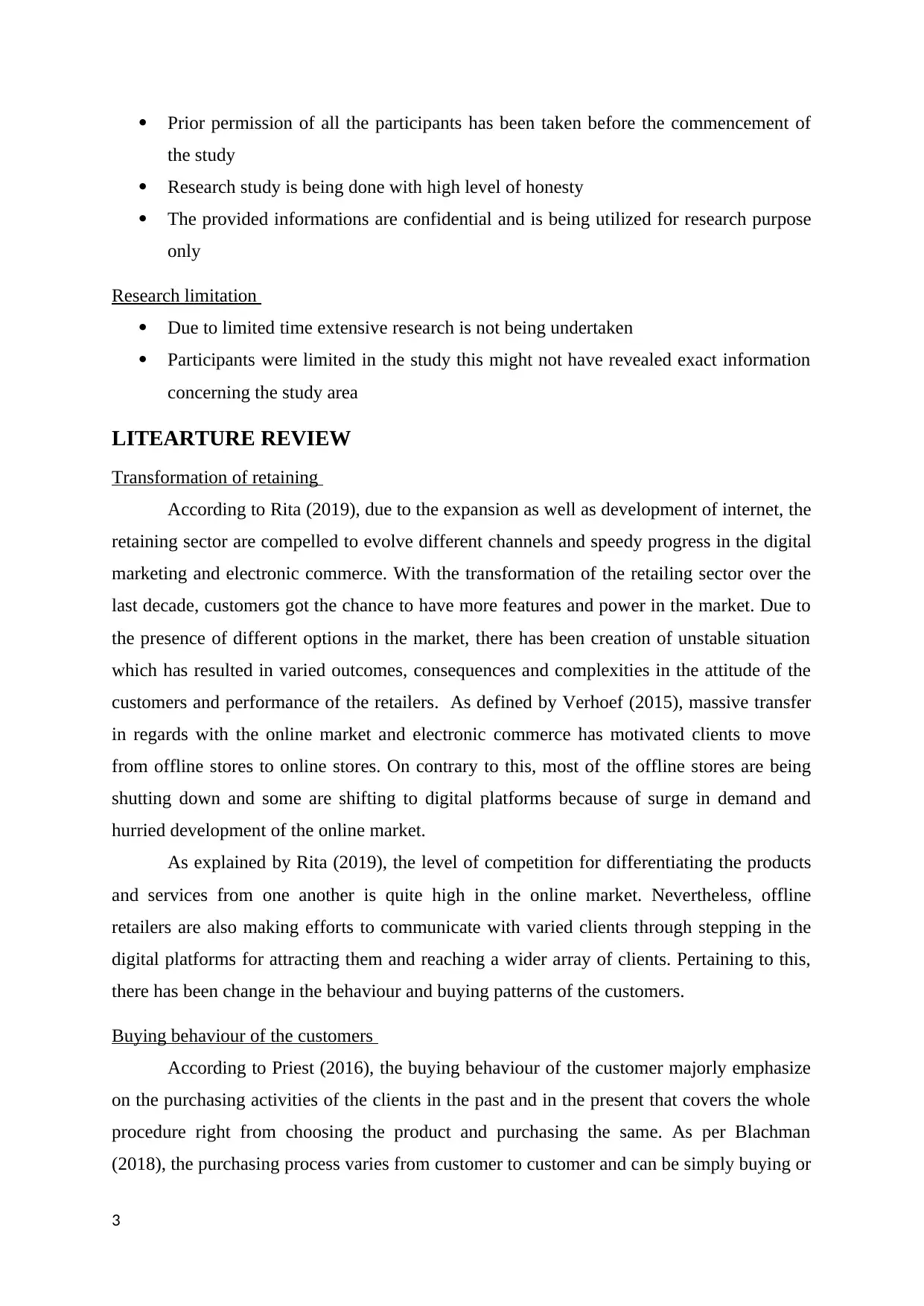
Prior permission of all the participants has been taken before the commencement of
the study
Research study is being done with high level of honesty
The provided informations are confidential and is being utilized for research purpose
only
Research limitation
Due to limited time extensive research is not being undertaken
Participants were limited in the study this might not have revealed exact information
concerning the study area
LITEARTURE REVIEW
Transformation of retaining
According to Rita (2019), due to the expansion as well as development of internet, the
retaining sector are compelled to evolve different channels and speedy progress in the digital
marketing and electronic commerce. With the transformation of the retailing sector over the
last decade, customers got the chance to have more features and power in the market. Due to
the presence of different options in the market, there has been creation of unstable situation
which has resulted in varied outcomes, consequences and complexities in the attitude of the
customers and performance of the retailers. As defined by Verhoef (2015), massive transfer
in regards with the online market and electronic commerce has motivated clients to move
from offline stores to online stores. On contrary to this, most of the offline stores are being
shutting down and some are shifting to digital platforms because of surge in demand and
hurried development of the online market.
As explained by Rita (2019), the level of competition for differentiating the products
and services from one another is quite high in the online market. Nevertheless, offline
retailers are also making efforts to communicate with varied clients through stepping in the
digital platforms for attracting them and reaching a wider array of clients. Pertaining to this,
there has been change in the behaviour and buying patterns of the customers.
Buying behaviour of the customers
According to Priest (2016), the buying behaviour of the customer majorly emphasize
on the purchasing activities of the clients in the past and in the present that covers the whole
procedure right from choosing the product and purchasing the same. As per Blachman
(2018), the purchasing process varies from customer to customer and can be simply buying or
3
the study
Research study is being done with high level of honesty
The provided informations are confidential and is being utilized for research purpose
only
Research limitation
Due to limited time extensive research is not being undertaken
Participants were limited in the study this might not have revealed exact information
concerning the study area
LITEARTURE REVIEW
Transformation of retaining
According to Rita (2019), due to the expansion as well as development of internet, the
retaining sector are compelled to evolve different channels and speedy progress in the digital
marketing and electronic commerce. With the transformation of the retailing sector over the
last decade, customers got the chance to have more features and power in the market. Due to
the presence of different options in the market, there has been creation of unstable situation
which has resulted in varied outcomes, consequences and complexities in the attitude of the
customers and performance of the retailers. As defined by Verhoef (2015), massive transfer
in regards with the online market and electronic commerce has motivated clients to move
from offline stores to online stores. On contrary to this, most of the offline stores are being
shutting down and some are shifting to digital platforms because of surge in demand and
hurried development of the online market.
As explained by Rita (2019), the level of competition for differentiating the products
and services from one another is quite high in the online market. Nevertheless, offline
retailers are also making efforts to communicate with varied clients through stepping in the
digital platforms for attracting them and reaching a wider array of clients. Pertaining to this,
there has been change in the behaviour and buying patterns of the customers.
Buying behaviour of the customers
According to Priest (2016), the buying behaviour of the customer majorly emphasize
on the purchasing activities of the clients in the past and in the present that covers the whole
procedure right from choosing the product and purchasing the same. As per Blachman
(2018), the purchasing process varies from customer to customer and can be simply buying or
3
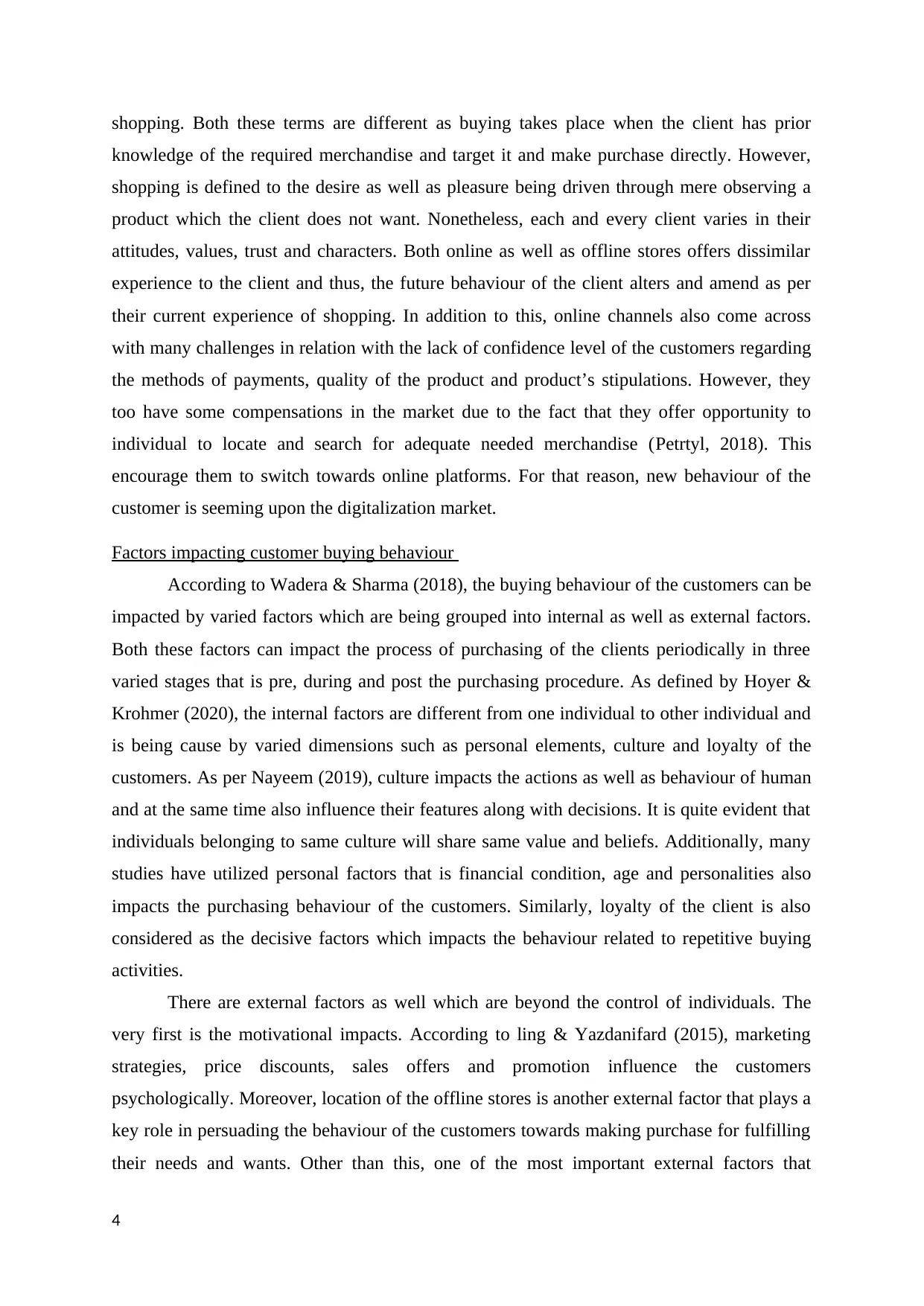
shopping. Both these terms are different as buying takes place when the client has prior
knowledge of the required merchandise and target it and make purchase directly. However,
shopping is defined to the desire as well as pleasure being driven through mere observing a
product which the client does not want. Nonetheless, each and every client varies in their
attitudes, values, trust and characters. Both online as well as offline stores offers dissimilar
experience to the client and thus, the future behaviour of the client alters and amend as per
their current experience of shopping. In addition to this, online channels also come across
with many challenges in relation with the lack of confidence level of the customers regarding
the methods of payments, quality of the product and product’s stipulations. However, they
too have some compensations in the market due to the fact that they offer opportunity to
individual to locate and search for adequate needed merchandise (Petrtyl, 2018). This
encourage them to switch towards online platforms. For that reason, new behaviour of the
customer is seeming upon the digitalization market.
Factors impacting customer buying behaviour
According to Wadera & Sharma (2018), the buying behaviour of the customers can be
impacted by varied factors which are being grouped into internal as well as external factors.
Both these factors can impact the process of purchasing of the clients periodically in three
varied stages that is pre, during and post the purchasing procedure. As defined by Hoyer &
Krohmer (2020), the internal factors are different from one individual to other individual and
is being cause by varied dimensions such as personal elements, culture and loyalty of the
customers. As per Nayeem (2019), culture impacts the actions as well as behaviour of human
and at the same time also influence their features along with decisions. It is quite evident that
individuals belonging to same culture will share same value and beliefs. Additionally, many
studies have utilized personal factors that is financial condition, age and personalities also
impacts the purchasing behaviour of the customers. Similarly, loyalty of the client is also
considered as the decisive factors which impacts the behaviour related to repetitive buying
activities.
There are external factors as well which are beyond the control of individuals. The
very first is the motivational impacts. According to ling & Yazdanifard (2015), marketing
strategies, price discounts, sales offers and promotion influence the customers
psychologically. Moreover, location of the offline stores is another external factor that plays a
key role in persuading the behaviour of the customers towards making purchase for fulfilling
their needs and wants. Other than this, one of the most important external factors that
4
knowledge of the required merchandise and target it and make purchase directly. However,
shopping is defined to the desire as well as pleasure being driven through mere observing a
product which the client does not want. Nonetheless, each and every client varies in their
attitudes, values, trust and characters. Both online as well as offline stores offers dissimilar
experience to the client and thus, the future behaviour of the client alters and amend as per
their current experience of shopping. In addition to this, online channels also come across
with many challenges in relation with the lack of confidence level of the customers regarding
the methods of payments, quality of the product and product’s stipulations. However, they
too have some compensations in the market due to the fact that they offer opportunity to
individual to locate and search for adequate needed merchandise (Petrtyl, 2018). This
encourage them to switch towards online platforms. For that reason, new behaviour of the
customer is seeming upon the digitalization market.
Factors impacting customer buying behaviour
According to Wadera & Sharma (2018), the buying behaviour of the customers can be
impacted by varied factors which are being grouped into internal as well as external factors.
Both these factors can impact the process of purchasing of the clients periodically in three
varied stages that is pre, during and post the purchasing procedure. As defined by Hoyer &
Krohmer (2020), the internal factors are different from one individual to other individual and
is being cause by varied dimensions such as personal elements, culture and loyalty of the
customers. As per Nayeem (2019), culture impacts the actions as well as behaviour of human
and at the same time also influence their features along with decisions. It is quite evident that
individuals belonging to same culture will share same value and beliefs. Additionally, many
studies have utilized personal factors that is financial condition, age and personalities also
impacts the purchasing behaviour of the customers. Similarly, loyalty of the client is also
considered as the decisive factors which impacts the behaviour related to repetitive buying
activities.
There are external factors as well which are beyond the control of individuals. The
very first is the motivational impacts. According to ling & Yazdanifard (2015), marketing
strategies, price discounts, sales offers and promotion influence the customers
psychologically. Moreover, location of the offline stores is another external factor that plays a
key role in persuading the behaviour of the customers towards making purchase for fulfilling
their needs and wants. Other than this, one of the most important external factors that
4
⊘ This is a preview!⊘
Do you want full access?
Subscribe today to unlock all pages.

Trusted by 1+ million students worldwide
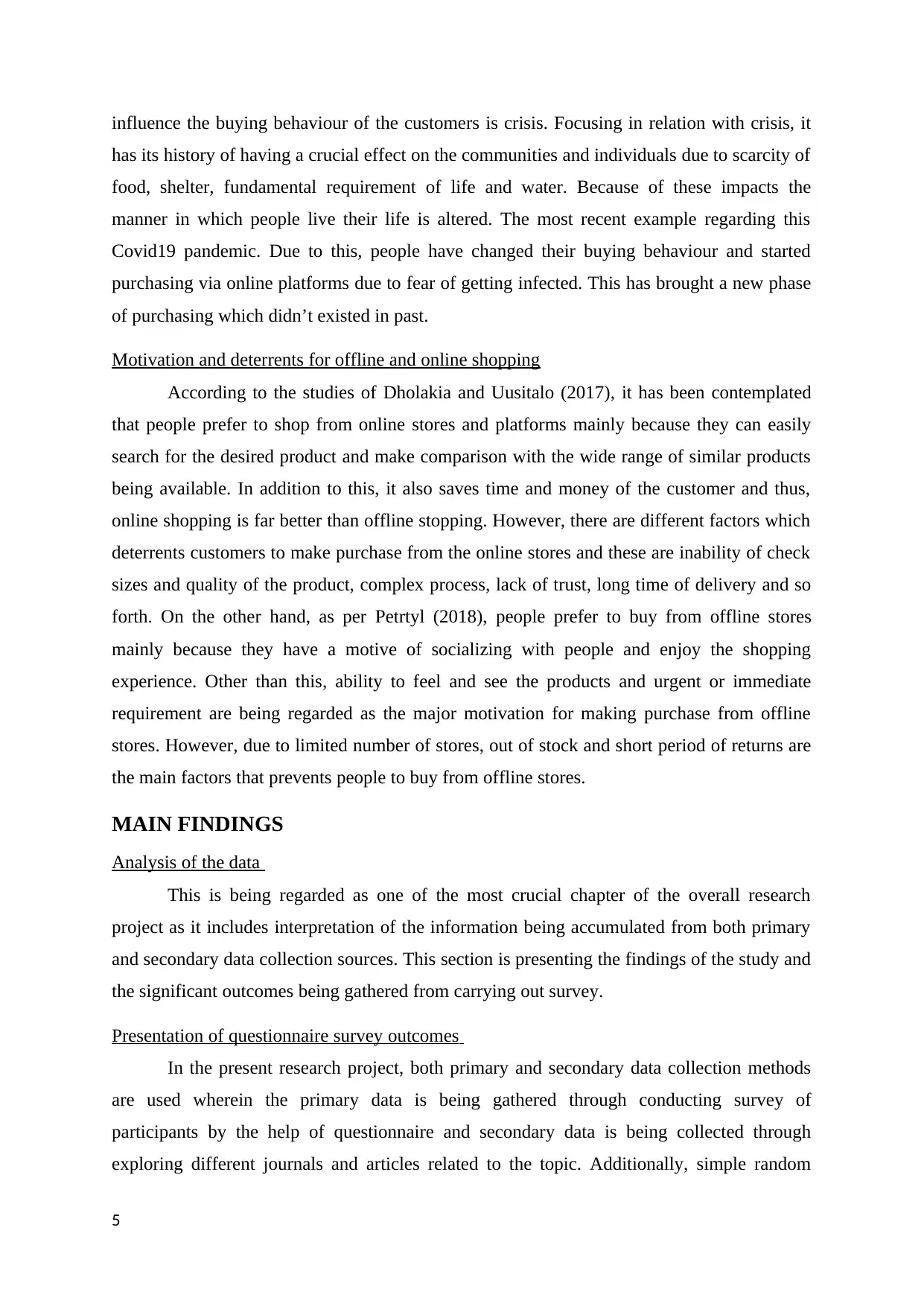
influence the buying behaviour of the customers is crisis. Focusing in relation with crisis, it
has its history of having a crucial effect on the communities and individuals due to scarcity of
food, shelter, fundamental requirement of life and water. Because of these impacts the
manner in which people live their life is altered. The most recent example regarding this
Covid19 pandemic. Due to this, people have changed their buying behaviour and started
purchasing via online platforms due to fear of getting infected. This has brought a new phase
of purchasing which didn’t existed in past.
Motivation and deterrents for offline and online shopping
According to the studies of Dholakia and Uusitalo (2017), it has been contemplated
that people prefer to shop from online stores and platforms mainly because they can easily
search for the desired product and make comparison with the wide range of similar products
being available. In addition to this, it also saves time and money of the customer and thus,
online shopping is far better than offline stopping. However, there are different factors which
deterrents customers to make purchase from the online stores and these are inability of check
sizes and quality of the product, complex process, lack of trust, long time of delivery and so
forth. On the other hand, as per Petrtyl (2018), people prefer to buy from offline stores
mainly because they have a motive of socializing with people and enjoy the shopping
experience. Other than this, ability to feel and see the products and urgent or immediate
requirement are being regarded as the major motivation for making purchase from offline
stores. However, due to limited number of stores, out of stock and short period of returns are
the main factors that prevents people to buy from offline stores.
MAIN FINDINGS
Analysis of the data
This is being regarded as one of the most crucial chapter of the overall research
project as it includes interpretation of the information being accumulated from both primary
and secondary data collection sources. This section is presenting the findings of the study and
the significant outcomes being gathered from carrying out survey.
Presentation of questionnaire survey outcomes
In the present research project, both primary and secondary data collection methods
are used wherein the primary data is being gathered through conducting survey of
participants by the help of questionnaire and secondary data is being collected through
exploring different journals and articles related to the topic. Additionally, simple random
5
has its history of having a crucial effect on the communities and individuals due to scarcity of
food, shelter, fundamental requirement of life and water. Because of these impacts the
manner in which people live their life is altered. The most recent example regarding this
Covid19 pandemic. Due to this, people have changed their buying behaviour and started
purchasing via online platforms due to fear of getting infected. This has brought a new phase
of purchasing which didn’t existed in past.
Motivation and deterrents for offline and online shopping
According to the studies of Dholakia and Uusitalo (2017), it has been contemplated
that people prefer to shop from online stores and platforms mainly because they can easily
search for the desired product and make comparison with the wide range of similar products
being available. In addition to this, it also saves time and money of the customer and thus,
online shopping is far better than offline stopping. However, there are different factors which
deterrents customers to make purchase from the online stores and these are inability of check
sizes and quality of the product, complex process, lack of trust, long time of delivery and so
forth. On the other hand, as per Petrtyl (2018), people prefer to buy from offline stores
mainly because they have a motive of socializing with people and enjoy the shopping
experience. Other than this, ability to feel and see the products and urgent or immediate
requirement are being regarded as the major motivation for making purchase from offline
stores. However, due to limited number of stores, out of stock and short period of returns are
the main factors that prevents people to buy from offline stores.
MAIN FINDINGS
Analysis of the data
This is being regarded as one of the most crucial chapter of the overall research
project as it includes interpretation of the information being accumulated from both primary
and secondary data collection sources. This section is presenting the findings of the study and
the significant outcomes being gathered from carrying out survey.
Presentation of questionnaire survey outcomes
In the present research project, both primary and secondary data collection methods
are used wherein the primary data is being gathered through conducting survey of
participants by the help of questionnaire and secondary data is being collected through
exploring different journals and articles related to the topic. Additionally, simple random
5
Paraphrase This Document
Need a fresh take? Get an instant paraphrase of this document with our AI Paraphraser
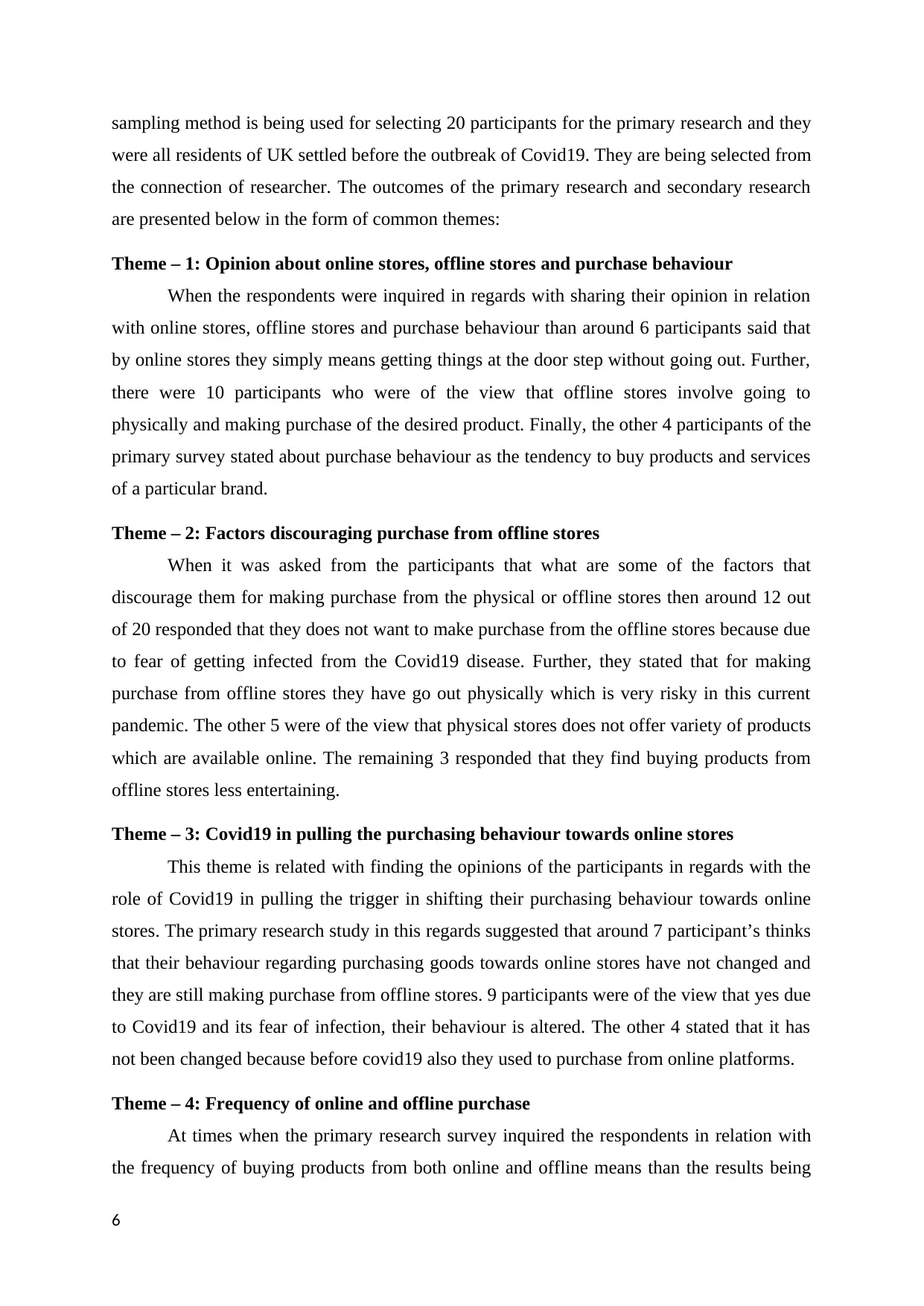
sampling method is being used for selecting 20 participants for the primary research and they
were all residents of UK settled before the outbreak of Covid19. They are being selected from
the connection of researcher. The outcomes of the primary research and secondary research
are presented below in the form of common themes:
Theme – 1: Opinion about online stores, offline stores and purchase behaviour
When the respondents were inquired in regards with sharing their opinion in relation
with online stores, offline stores and purchase behaviour than around 6 participants said that
by online stores they simply means getting things at the door step without going out. Further,
there were 10 participants who were of the view that offline stores involve going to
physically and making purchase of the desired product. Finally, the other 4 participants of the
primary survey stated about purchase behaviour as the tendency to buy products and services
of a particular brand.
Theme – 2: Factors discouraging purchase from offline stores
When it was asked from the participants that what are some of the factors that
discourage them for making purchase from the physical or offline stores then around 12 out
of 20 responded that they does not want to make purchase from the offline stores because due
to fear of getting infected from the Covid19 disease. Further, they stated that for making
purchase from offline stores they have go out physically which is very risky in this current
pandemic. The other 5 were of the view that physical stores does not offer variety of products
which are available online. The remaining 3 responded that they find buying products from
offline stores less entertaining.
Theme – 3: Covid19 in pulling the purchasing behaviour towards online stores
This theme is related with finding the opinions of the participants in regards with the
role of Covid19 in pulling the trigger in shifting their purchasing behaviour towards online
stores. The primary research study in this regards suggested that around 7 participant’s thinks
that their behaviour regarding purchasing goods towards online stores have not changed and
they are still making purchase from offline stores. 9 participants were of the view that yes due
to Covid19 and its fear of infection, their behaviour is altered. The other 4 stated that it has
not been changed because before covid19 also they used to purchase from online platforms.
Theme – 4: Frequency of online and offline purchase
At times when the primary research survey inquired the respondents in relation with
the frequency of buying products from both online and offline means than the results being
6
were all residents of UK settled before the outbreak of Covid19. They are being selected from
the connection of researcher. The outcomes of the primary research and secondary research
are presented below in the form of common themes:
Theme – 1: Opinion about online stores, offline stores and purchase behaviour
When the respondents were inquired in regards with sharing their opinion in relation
with online stores, offline stores and purchase behaviour than around 6 participants said that
by online stores they simply means getting things at the door step without going out. Further,
there were 10 participants who were of the view that offline stores involve going to
physically and making purchase of the desired product. Finally, the other 4 participants of the
primary survey stated about purchase behaviour as the tendency to buy products and services
of a particular brand.
Theme – 2: Factors discouraging purchase from offline stores
When it was asked from the participants that what are some of the factors that
discourage them for making purchase from the physical or offline stores then around 12 out
of 20 responded that they does not want to make purchase from the offline stores because due
to fear of getting infected from the Covid19 disease. Further, they stated that for making
purchase from offline stores they have go out physically which is very risky in this current
pandemic. The other 5 were of the view that physical stores does not offer variety of products
which are available online. The remaining 3 responded that they find buying products from
offline stores less entertaining.
Theme – 3: Covid19 in pulling the purchasing behaviour towards online stores
This theme is related with finding the opinions of the participants in regards with the
role of Covid19 in pulling the trigger in shifting their purchasing behaviour towards online
stores. The primary research study in this regards suggested that around 7 participant’s thinks
that their behaviour regarding purchasing goods towards online stores have not changed and
they are still making purchase from offline stores. 9 participants were of the view that yes due
to Covid19 and its fear of infection, their behaviour is altered. The other 4 stated that it has
not been changed because before covid19 also they used to purchase from online platforms.
Theme – 4: Frequency of online and offline purchase
At times when the primary research survey inquired the respondents in relation with
the frequency of buying products from both online and offline means than the results being
6
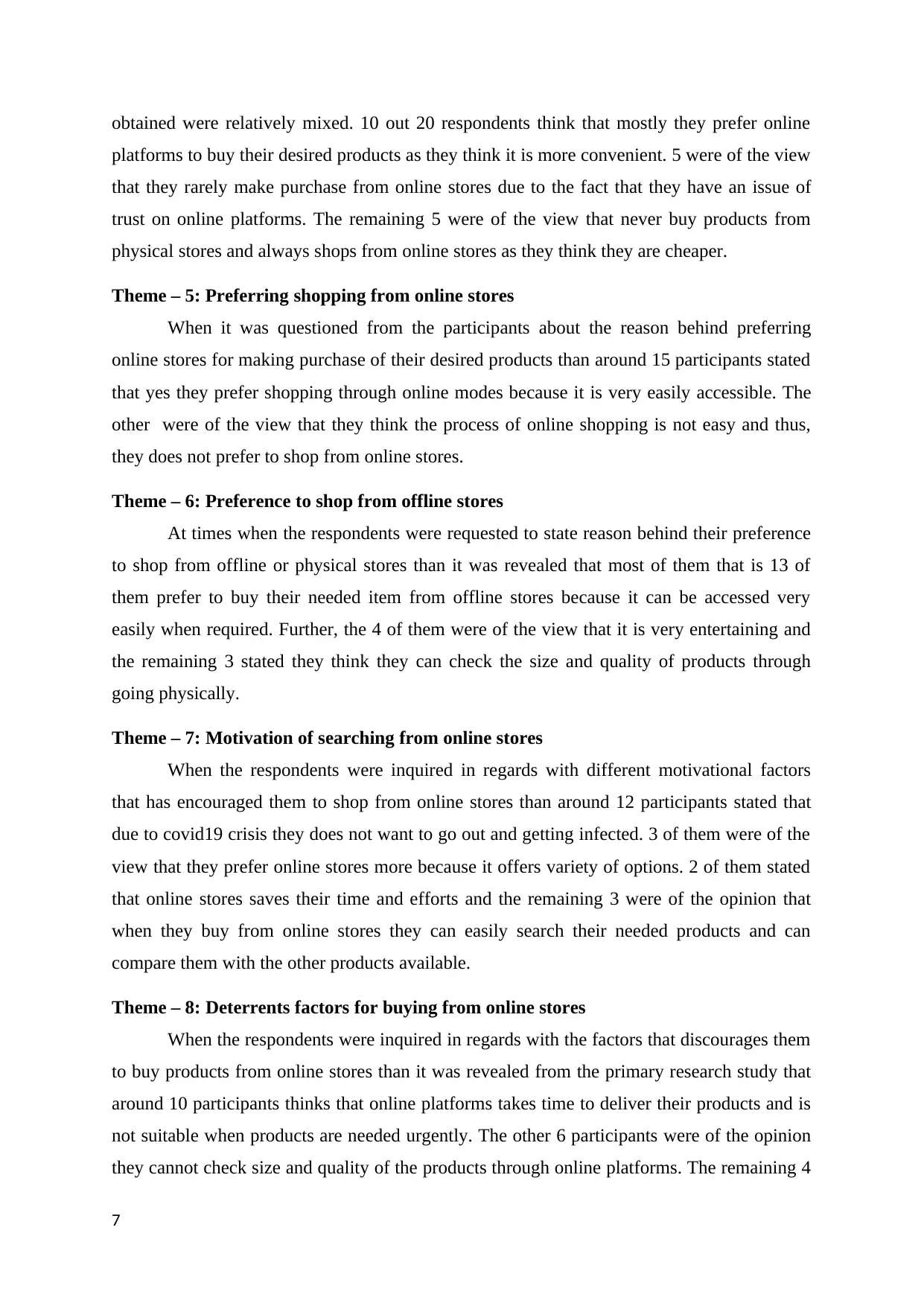
obtained were relatively mixed. 10 out 20 respondents think that mostly they prefer online
platforms to buy their desired products as they think it is more convenient. 5 were of the view
that they rarely make purchase from online stores due to the fact that they have an issue of
trust on online platforms. The remaining 5 were of the view that never buy products from
physical stores and always shops from online stores as they think they are cheaper.
Theme – 5: Preferring shopping from online stores
When it was questioned from the participants about the reason behind preferring
online stores for making purchase of their desired products than around 15 participants stated
that yes they prefer shopping through online modes because it is very easily accessible. The
other were of the view that they think the process of online shopping is not easy and thus,
they does not prefer to shop from online stores.
Theme – 6: Preference to shop from offline stores
At times when the respondents were requested to state reason behind their preference
to shop from offline or physical stores than it was revealed that most of them that is 13 of
them prefer to buy their needed item from offline stores because it can be accessed very
easily when required. Further, the 4 of them were of the view that it is very entertaining and
the remaining 3 stated they think they can check the size and quality of products through
going physically.
Theme – 7: Motivation of searching from online stores
When the respondents were inquired in regards with different motivational factors
that has encouraged them to shop from online stores than around 12 participants stated that
due to covid19 crisis they does not want to go out and getting infected. 3 of them were of the
view that they prefer online stores more because it offers variety of options. 2 of them stated
that online stores saves their time and efforts and the remaining 3 were of the opinion that
when they buy from online stores they can easily search their needed products and can
compare them with the other products available.
Theme – 8: Deterrents factors for buying from online stores
When the respondents were inquired in regards with the factors that discourages them
to buy products from online stores than it was revealed from the primary research study that
around 10 participants thinks that online platforms takes time to deliver their products and is
not suitable when products are needed urgently. The other 6 participants were of the opinion
they cannot check size and quality of the products through online platforms. The remaining 4
7
platforms to buy their desired products as they think it is more convenient. 5 were of the view
that they rarely make purchase from online stores due to the fact that they have an issue of
trust on online platforms. The remaining 5 were of the view that never buy products from
physical stores and always shops from online stores as they think they are cheaper.
Theme – 5: Preferring shopping from online stores
When it was questioned from the participants about the reason behind preferring
online stores for making purchase of their desired products than around 15 participants stated
that yes they prefer shopping through online modes because it is very easily accessible. The
other were of the view that they think the process of online shopping is not easy and thus,
they does not prefer to shop from online stores.
Theme – 6: Preference to shop from offline stores
At times when the respondents were requested to state reason behind their preference
to shop from offline or physical stores than it was revealed that most of them that is 13 of
them prefer to buy their needed item from offline stores because it can be accessed very
easily when required. Further, the 4 of them were of the view that it is very entertaining and
the remaining 3 stated they think they can check the size and quality of products through
going physically.
Theme – 7: Motivation of searching from online stores
When the respondents were inquired in regards with different motivational factors
that has encouraged them to shop from online stores than around 12 participants stated that
due to covid19 crisis they does not want to go out and getting infected. 3 of them were of the
view that they prefer online stores more because it offers variety of options. 2 of them stated
that online stores saves their time and efforts and the remaining 3 were of the opinion that
when they buy from online stores they can easily search their needed products and can
compare them with the other products available.
Theme – 8: Deterrents factors for buying from online stores
When the respondents were inquired in regards with the factors that discourages them
to buy products from online stores than it was revealed from the primary research study that
around 10 participants thinks that online platforms takes time to deliver their products and is
not suitable when products are needed urgently. The other 6 participants were of the opinion
they cannot check size and quality of the products through online platforms. The remaining 4
7
⊘ This is a preview!⊘
Do you want full access?
Subscribe today to unlock all pages.

Trusted by 1+ million students worldwide
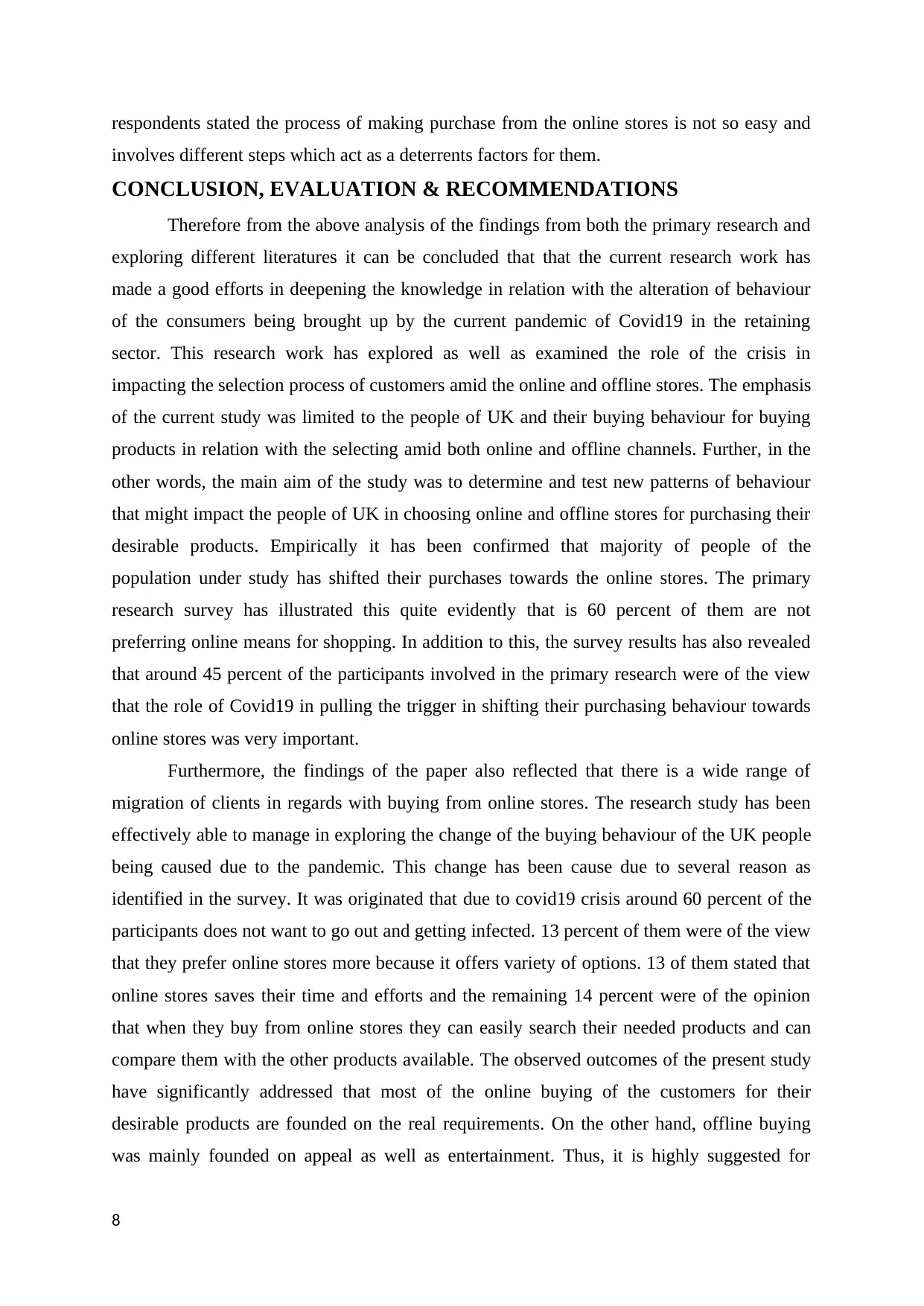
respondents stated the process of making purchase from the online stores is not so easy and
involves different steps which act as a deterrents factors for them.
CONCLUSION, EVALUATION & RECOMMENDATIONS
Therefore from the above analysis of the findings from both the primary research and
exploring different literatures it can be concluded that that the current research work has
made a good efforts in deepening the knowledge in relation with the alteration of behaviour
of the consumers being brought up by the current pandemic of Covid19 in the retaining
sector. This research work has explored as well as examined the role of the crisis in
impacting the selection process of customers amid the online and offline stores. The emphasis
of the current study was limited to the people of UK and their buying behaviour for buying
products in relation with the selecting amid both online and offline channels. Further, in the
other words, the main aim of the study was to determine and test new patterns of behaviour
that might impact the people of UK in choosing online and offline stores for purchasing their
desirable products. Empirically it has been confirmed that majority of people of the
population under study has shifted their purchases towards the online stores. The primary
research survey has illustrated this quite evidently that is 60 percent of them are not
preferring online means for shopping. In addition to this, the survey results has also revealed
that around 45 percent of the participants involved in the primary research were of the view
that the role of Covid19 in pulling the trigger in shifting their purchasing behaviour towards
online stores was very important.
Furthermore, the findings of the paper also reflected that there is a wide range of
migration of clients in regards with buying from online stores. The research study has been
effectively able to manage in exploring the change of the buying behaviour of the UK people
being caused due to the pandemic. This change has been cause due to several reason as
identified in the survey. It was originated that due to covid19 crisis around 60 percent of the
participants does not want to go out and getting infected. 13 percent of them were of the view
that they prefer online stores more because it offers variety of options. 13 of them stated that
online stores saves their time and efforts and the remaining 14 percent were of the opinion
that when they buy from online stores they can easily search their needed products and can
compare them with the other products available. The observed outcomes of the present study
have significantly addressed that most of the online buying of the customers for their
desirable products are founded on the real requirements. On the other hand, offline buying
was mainly founded on appeal as well as entertainment. Thus, it is highly suggested for
8
involves different steps which act as a deterrents factors for them.
CONCLUSION, EVALUATION & RECOMMENDATIONS
Therefore from the above analysis of the findings from both the primary research and
exploring different literatures it can be concluded that that the current research work has
made a good efforts in deepening the knowledge in relation with the alteration of behaviour
of the consumers being brought up by the current pandemic of Covid19 in the retaining
sector. This research work has explored as well as examined the role of the crisis in
impacting the selection process of customers amid the online and offline stores. The emphasis
of the current study was limited to the people of UK and their buying behaviour for buying
products in relation with the selecting amid both online and offline channels. Further, in the
other words, the main aim of the study was to determine and test new patterns of behaviour
that might impact the people of UK in choosing online and offline stores for purchasing their
desirable products. Empirically it has been confirmed that majority of people of the
population under study has shifted their purchases towards the online stores. The primary
research survey has illustrated this quite evidently that is 60 percent of them are not
preferring online means for shopping. In addition to this, the survey results has also revealed
that around 45 percent of the participants involved in the primary research were of the view
that the role of Covid19 in pulling the trigger in shifting their purchasing behaviour towards
online stores was very important.
Furthermore, the findings of the paper also reflected that there is a wide range of
migration of clients in regards with buying from online stores. The research study has been
effectively able to manage in exploring the change of the buying behaviour of the UK people
being caused due to the pandemic. This change has been cause due to several reason as
identified in the survey. It was originated that due to covid19 crisis around 60 percent of the
participants does not want to go out and getting infected. 13 percent of them were of the view
that they prefer online stores more because it offers variety of options. 13 of them stated that
online stores saves their time and efforts and the remaining 14 percent were of the opinion
that when they buy from online stores they can easily search their needed products and can
compare them with the other products available. The observed outcomes of the present study
have significantly addressed that most of the online buying of the customers for their
desirable products are founded on the real requirements. On the other hand, offline buying
was mainly founded on appeal as well as entertainment. Thus, it is highly suggested for
8
Paraphrase This Document
Need a fresh take? Get an instant paraphrase of this document with our AI Paraphraser
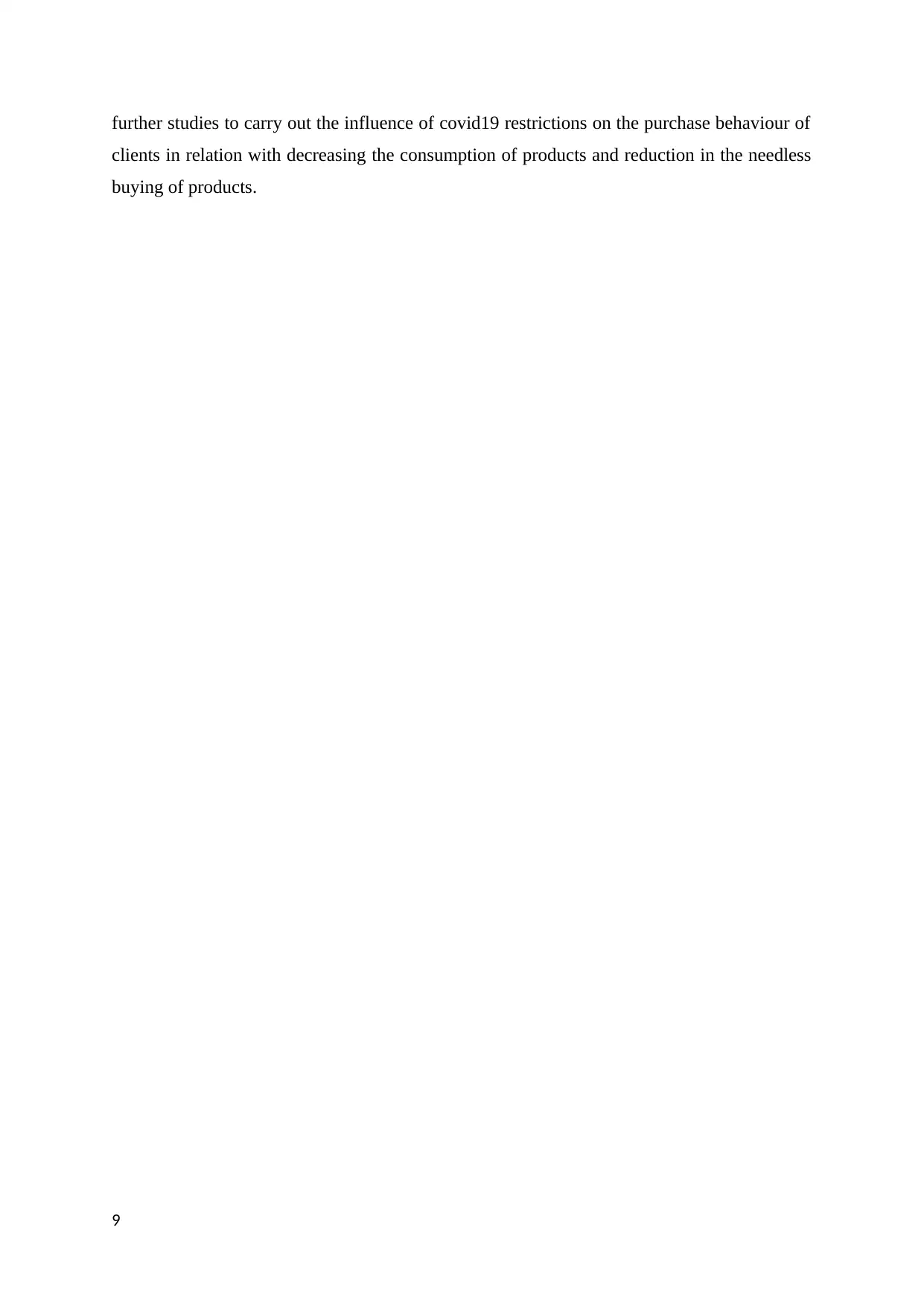
further studies to carry out the influence of covid19 restrictions on the purchase behaviour of
clients in relation with decreasing the consumption of products and reduction in the needless
buying of products.
9
clients in relation with decreasing the consumption of products and reduction in the needless
buying of products.
9
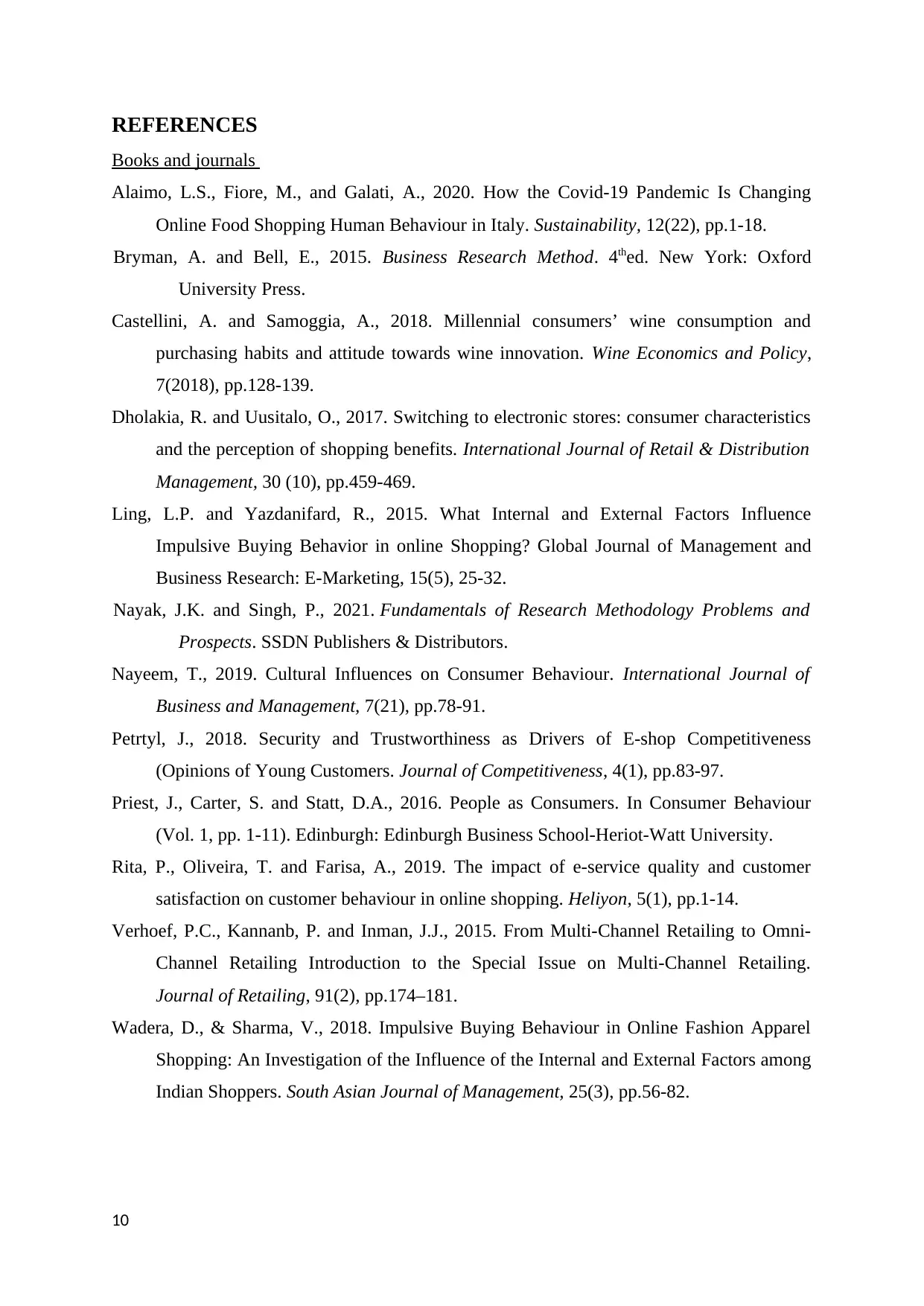
REFERENCES
Books and journals
Alaimo, L.S., Fiore, M., and Galati, A., 2020. How the Covid-19 Pandemic Is Changing
Online Food Shopping Human Behaviour in Italy. Sustainability, 12(22), pp.1-18.
Bryman, A. and Bell, E., 2015. Business Research Method. 4thed. New York: Oxford
University Press.
Castellini, A. and Samoggia, A., 2018. Millennial consumers’ wine consumption and
purchasing habits and attitude towards wine innovation. Wine Economics and Policy,
7(2018), pp.128-139.
Dholakia, R. and Uusitalo, O., 2017. Switching to electronic stores: consumer characteristics
and the perception of shopping benefits. International Journal of Retail & Distribution
Management, 30 (10), pp.459-469.
Ling, L.P. and Yazdanifard, R., 2015. What Internal and External Factors Influence
Impulsive Buying Behavior in online Shopping? Global Journal of Management and
Business Research: E-Marketing, 15(5), 25-32.
Nayak, J.K. and Singh, P., 2021. Fundamentals of Research Methodology Problems and
Prospects. SSDN Publishers & Distributors.
Nayeem, T., 2019. Cultural Influences on Consumer Behaviour. International Journal of
Business and Management, 7(21), pp.78-91.
Petrtyl, J., 2018. Security and Trustworthiness as Drivers of E-shop Competitiveness
(Opinions of Young Customers. Journal of Competitiveness, 4(1), pp.83-97.
Priest, J., Carter, S. and Statt, D.A., 2016. People as Consumers. In Consumer Behaviour
(Vol. 1, pp. 1-11). Edinburgh: Edinburgh Business School-Heriot-Watt University.
Rita, P., Oliveira, T. and Farisa, A., 2019. The impact of e-service quality and customer
satisfaction on customer behaviour in online shopping. Heliyon, 5(1), pp.1-14.
Verhoef, P.C., Kannanb, P. and Inman, J.J., 2015. From Multi-Channel Retailing to Omni-
Channel Retailing Introduction to the Special Issue on Multi-Channel Retailing.
Journal of Retailing, 91(2), pp.174–181.
Wadera, D., & Sharma, V., 2018. Impulsive Buying Behaviour in Online Fashion Apparel
Shopping: An Investigation of the Influence of the Internal and External Factors among
Indian Shoppers. South Asian Journal of Management, 25(3), pp.56-82.
10
Books and journals
Alaimo, L.S., Fiore, M., and Galati, A., 2020. How the Covid-19 Pandemic Is Changing
Online Food Shopping Human Behaviour in Italy. Sustainability, 12(22), pp.1-18.
Bryman, A. and Bell, E., 2015. Business Research Method. 4thed. New York: Oxford
University Press.
Castellini, A. and Samoggia, A., 2018. Millennial consumers’ wine consumption and
purchasing habits and attitude towards wine innovation. Wine Economics and Policy,
7(2018), pp.128-139.
Dholakia, R. and Uusitalo, O., 2017. Switching to electronic stores: consumer characteristics
and the perception of shopping benefits. International Journal of Retail & Distribution
Management, 30 (10), pp.459-469.
Ling, L.P. and Yazdanifard, R., 2015. What Internal and External Factors Influence
Impulsive Buying Behavior in online Shopping? Global Journal of Management and
Business Research: E-Marketing, 15(5), 25-32.
Nayak, J.K. and Singh, P., 2021. Fundamentals of Research Methodology Problems and
Prospects. SSDN Publishers & Distributors.
Nayeem, T., 2019. Cultural Influences on Consumer Behaviour. International Journal of
Business and Management, 7(21), pp.78-91.
Petrtyl, J., 2018. Security and Trustworthiness as Drivers of E-shop Competitiveness
(Opinions of Young Customers. Journal of Competitiveness, 4(1), pp.83-97.
Priest, J., Carter, S. and Statt, D.A., 2016. People as Consumers. In Consumer Behaviour
(Vol. 1, pp. 1-11). Edinburgh: Edinburgh Business School-Heriot-Watt University.
Rita, P., Oliveira, T. and Farisa, A., 2019. The impact of e-service quality and customer
satisfaction on customer behaviour in online shopping. Heliyon, 5(1), pp.1-14.
Verhoef, P.C., Kannanb, P. and Inman, J.J., 2015. From Multi-Channel Retailing to Omni-
Channel Retailing Introduction to the Special Issue on Multi-Channel Retailing.
Journal of Retailing, 91(2), pp.174–181.
Wadera, D., & Sharma, V., 2018. Impulsive Buying Behaviour in Online Fashion Apparel
Shopping: An Investigation of the Influence of the Internal and External Factors among
Indian Shoppers. South Asian Journal of Management, 25(3), pp.56-82.
10
⊘ This is a preview!⊘
Do you want full access?
Subscribe today to unlock all pages.

Trusted by 1+ million students worldwide
1 out of 15
Related Documents
Your All-in-One AI-Powered Toolkit for Academic Success.
+13062052269
info@desklib.com
Available 24*7 on WhatsApp / Email
![[object Object]](/_next/static/media/star-bottom.7253800d.svg)
Unlock your academic potential
Copyright © 2020–2025 A2Z Services. All Rights Reserved. Developed and managed by ZUCOL.





